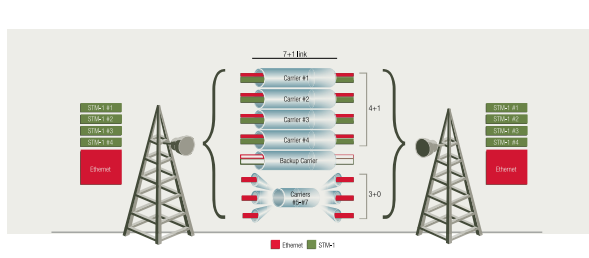Legacy technologies can be compared to holding on to an old car, if by a thread. You cling to it because it’s always been so reliable. But the car requires a lot of maintenance, and admit it, it’s a real gas guzzler. So most of the time, it just sits idly in your garage as a backup.
Operators who long-haul SONET/SDH traffic across multiple carriers face the same dilemma. Although, at some point, all-packet networks will take over, we’re not there yet. Thus, you need to keep supporting SONET/SDH, even though you need to dedicate a radio carrier running at lower modulation for each STM-1/OC-3 signal, and even though it requires an additional carrier as a backup channel – which generally remains unused.
So how do you optimize your long haul capacity?
Another dilemma: when you have a car sitting in your garage, there are few additional ongoing expenses. That's not the case with your network: your long-haul operational efficiency decreases significantly because:
- Sub-optimal modulation means low capacity per carrier, costing you more per byte
- SONET/SDH’s N+1 protection configuration wastes equipment and spectrum
- Migration from a hybrid to an all-packet network requires even more equipment and lengthy downtime
Sub-optimal use of equipment and spectrum resources
The good news is you can optimize your long-haul links, delivering at least 20% more capacity over each carrier with 25% fewer radios, by applying hybrid multicarrier adaptive bandwidth control (hybrid MC-ABC).
Using this breakthrough technology, all radios carry all traffic at all times, regardless if it is SDH or IP, without the need for reserving a dedicated carrier to protect SDH traffic in case of failure. Hybrid MC-ABC redistributes the SDH virtual containers and IP traffic over the available carriers for transmission over the wireless link. The redistributed traffic is dynamically allocated across all available wireless carriers, distributed according to each carrier’s radio propagation conditions, i.e., the current available throughput rate. This mechanism enables the use of all available channels (including the protection channel). At the same time, all carriers can run at the highest modulation, no matter what type of traffic they carry.
Thus, by using hybrid MC-ABC, you achieve higher resiliency and better link redundancy, ensuring higher service availability and spectrum efficiency.
This technology and capability are already built into Ceragon’s IP-20LH Long Haul solution, which also features link protection. Unlike the N+1 SDH/SONET scheme, hybrid MC-ABC provides reliable transmission even when more than one channel is lost.
Let’s illustrate: suppose you have a 6GHz long-haul link carrying 4 x STM-1 and 600Mbps of high-priority Ethernet traffic, using 28MHz channels. The current architecture requires an 8+0 trunk.
However, when using hybrid MC-ABC to carry the same amount of traffic, you can save 25% in equipment, frequency, and power, by removing the backup carrier and increasing the modulation on all other carriers, serving the same capacity with only six carriers.
Now, if only you could breathe new life into your car as efficiently….
To find out more about Ceragon’s approach to enabling more protected capacity with fewer carriers, download the FibeAir IP-20LH Multi-Carrier Trunk Node brochure here.

